Lisa Sodders, Space Systems Command Public Affairs
Over the past two years, Space Systems Command’s Commercial Space Office (COMSO) has been reinventing space acquisitions—partnering with commercial as well as governmental partners, shaping the “demand signal” to industry through a variety of vectors, and integrating new and emerging technology throughout the U.S. Space Force.
COMSO—which was rebranded from the Commercial Services Office to the Commercial Space Office two years ago—is responsible for accelerating commercial partnerships to deliver “fight tonight” capabilities aligned with warfighter needs at a faster pace and with lower cost compared to traditional military acquisition methods. It was instrumental in creating the U.S. Space Force’s Commercial Space Strategy and is the executive agent of that strategy.


Colonel Rich
Kniseley
“Our commercial partners are extremely important to us,” said Col. Rich Kniseley, senior materiel leader of COMSO, who is currently transitioning to a new role in the Pentagon. We can’t outpace our adversaries on our own. Building new capabilities takes longer than buying what’s already available on—or can be adapted from—the commercial market. The U.S Space Force also doesn’t have the monopoly on innovation, and by teaming up with the commercial space industry, we’re able to tap into game-changing new technology – and also help foster the development of the kinds of tech that can keep us ahead of the threat,” Kniseley said.
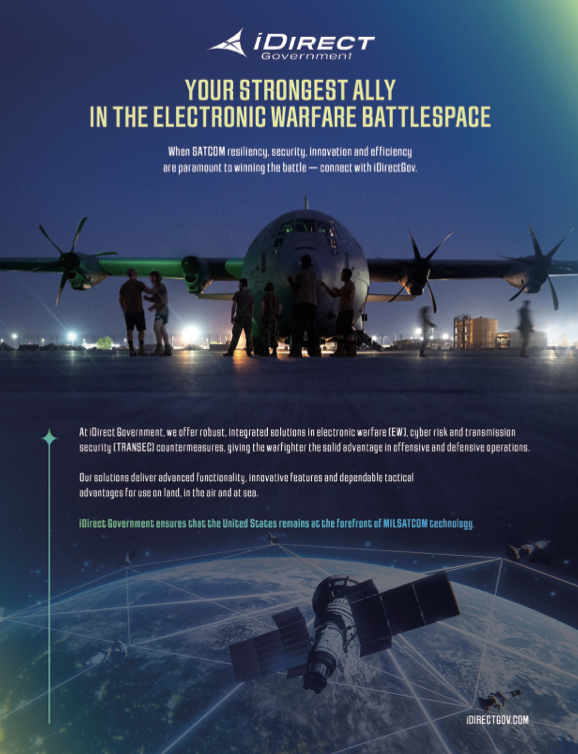 With Colonlel Kniseley’s transition, Lieutenant Colonel Timothy Trimailo became the new head of COMSO.
With Colonlel Kniseley’s transition, Lieutenant Colonel Timothy Trimailo became the new head of COMSO.

Lieutenant
Colonel Timothy
Trimailo“The COMSO team has established an amazing framework for commercial capability integration and I’m incredibly excited to lead this organization into the future,” Trimailo said. “Commercial innovation has been an obsession for me throughout my career and it’s an honor to lead this team. We will be laser-focused on building upon the solid foundation set by Col. Kniseley, delivering commercial capabilities to the warfighter and continuing to develop the framework to exploit what we have, buy what we can, and build only what we must.” COMSO originally started with a budget of zero. With the support of the Senate Appropriations Committee, COMSO was funded in FY24 and FY25. Those funds directly supported the success of Tactical Surveillance, Reconnaissance, and Tracking (TacSRT) and started the Commercial Augmentation Space Reserve (CASR).
COMSO also negotiated with the Office of the Secretary of Defense and the Secretary of the Air Force Financial Management and Comptroller to stand up a Space Force working capital fund expected to come on line in October of 2025. This will come from the greater Air Force working capital fund to ensure the successful transition of the Commercial SATCOM mission from the Defense Information Systems Agency (DISA) to the Space Force.
Under the COMSO umbrella is a network of programs, offices, and initiatives designed to help COMSO take full advantage of the commercial space industry. These include Front Door, SpaceWERX, the Global Data Marketplace, the Commercial Satellite Communications Office (CSCO), the Commercial Space Marketplace for Innovation and Collaboration center (COSMIC) and the CASR.
“If all of the different programs and funding vehicles sound complex, that’s because they are – that’s why we have COMSO, and why SSC is the acquisition arm of the U.S. Space Force,” Kniseley said. “We leave no stone unturned when it comes to delivering the capabilities our warfighters need to defend our nation.”
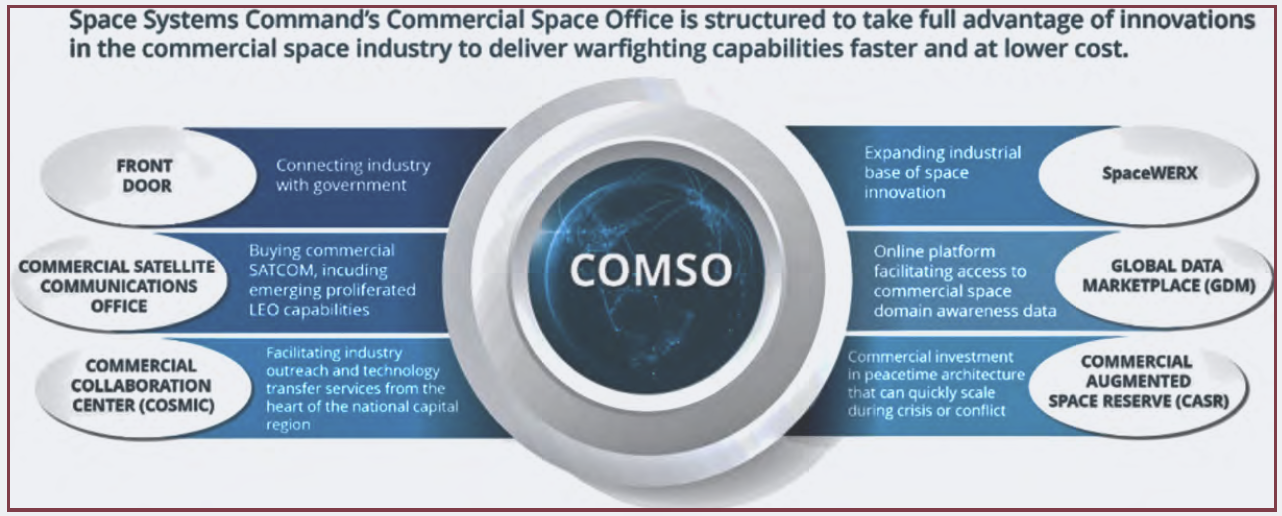
SSC’s Front Door is a first-step portal for early-stage startups, non-traditional partners, and other commercial vendors to engage with USSF and serves as a central point of connection and useful information exchange for industry and government stakeholders. Over the last two years, Front Door has expanded, streamlined its processes, automated its entry portal, added a Customer Relationship Management (CRM) system, and increased the number of Reverse Industry Days it hosts.
“We brought in additional resources for Front Door that have helped streamline our processes, reduce our response times, and process more companies, especially to the direct-to-phase-two routes,” Kniseley said.
More than 900 vendors have been processed through Front Door to date, helping to build an “enhanced space catalog” to help match vendors with the right government organization and/or allied partner, said Vic Vigliotti, Front Door’s director.
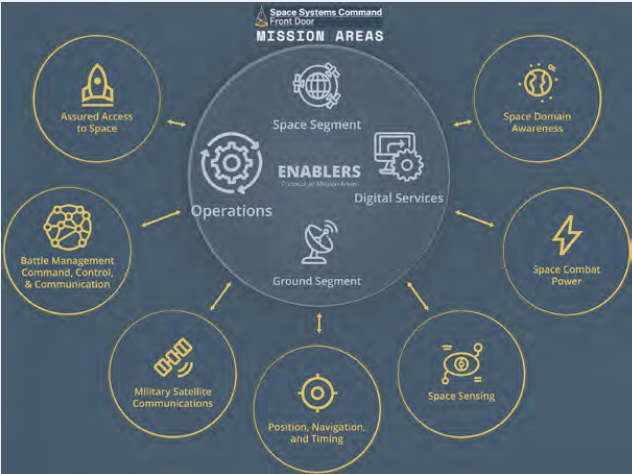 At the recent Space Symposium 2025, Front Door also announced a new initiative, Orbital Watch, which will provide commercial space industry companies with critical, unclassified threat information on a regular basis.
At the recent Space Symposium 2025, Front Door also announced a new initiative, Orbital Watch, which will provide commercial space industry companies with critical, unclassified threat information on a regular basis.
“With Orbital Watch, our commercial space industry partners will be receiving unclassified threat information that will not only enable them to work with us to provide needed capabilities, but also to protect themselves against the kinds of threats our adversaries are presenting,” Kniseley said.
SpaceWERX is a division of the U.S. Air Force’s AFWERX program dedicated to innovation in military space. Its mission is to accelerate agile and affordable capability transitions by teaming leaders in innovative technology with Guardian talent.
SpaceWerx allocates approximately $460 million per year across the Space Force through a number of programs, including the Small Business Innovation Research (SBIR) program and the Small Business Technology Transfer Programs (STTR program).
Since 2023, SpaceWERX has awarded 918 SBIR/STTR contracts , valued at $1.03 billion to 511 different companies.
Because military spending is ultimately funded by the taxpayer, it is governed by a plethora of rules and regulations to make sure those funds are being spent wisely, which can often make it difficult for emerging tech firms and smaller companies that have never done business with the U.S. military to navigate the process.
The Strategic Funding Increase (STRATFI) and Tactical Funding Increase (TACFI) programs are designed to bridge the capability gap between SBIR/STTR (Phase II efforts and Phase III scaling efforts), facilitating the delivery of strategic capabilities for the USSF.
TACFI is focused on transitioning smaller-scale, tactical capabilities at the operational level. STRATFI is focused on large-scale, strategic capabilities at the Department of the Air Force (DAF) level.
With both options available to SBIR/STTR Phase II companies, Air and Space Forces are able to scale innovation support across technology sectors and mission needs.
 Since 2023, SpaceWERX supported 65 awards through the Strategic Funding Increase and Tactical Funding Increase programs—24 through STRATFI and 41 through TACFI—leveraging a combined total of more than $1.43 billion, including approximately $371 million in SBIR/STTR funds, $497 million in government matching, and $564 million in private investment.
Since 2023, SpaceWERX supported 65 awards through the Strategic Funding Increase and Tactical Funding Increase programs—24 through STRATFI and 41 through TACFI—leveraging a combined total of more than $1.43 billion, including approximately $371 million in SBIR/STTR funds, $497 million in government matching, and $564 million in private investment.
The Commercial Satellite Communications Office (CSCO) is a central marketplace for purchasing commercial satellite communications (SATCOM) for combatant commands. Buying commercial services to augment military satellites is not new, but the abundance of commercial providers operating in proliferated Low Earth Orbit (pLEO) is.
In 2023, CSCO facilitated a ground-breaking, $900 million, pLEO Indefinite Delivery, Indefinite Quantity (IDIQ) contract for commercial SATCOM procurement. Congress recently raised the ceiling for this contract to $13 billion and is transitioning management from DISA to CSCO.
“When the pLEO IDIQ transitions from DISA, the contract will have more manpower assigned to it, more onboarding resources for vendors, and will be able to respond faster,” Kniseley said. “We’ll be streamlining the process; reviewing and matching customer to vendor faster. The pLEO effort groups multiple requirements together so we have better buying power. At the same time, we can help vendors align with the best kind of contract and funding – it doesn’t have to be pLEO. Because we have so many contracts with CSCO, a vendor may think pLEO is the right way, but we may have better deals for them.”
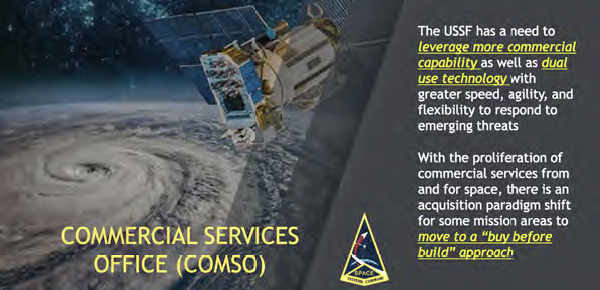 New to the COMSO portfolio is the Commercial Augmentation Space Reserve (CASR), an SSC strategic initiative designed to ensure access to commercial capabilities throughout the spectrum of conflict while maintaining security, reliability, and availability. COMSO recently awarded its first four pilot contracts with each of the four companies signing three-month contracts to provide “peacetime capability” for Space Domain Awareness (SDA). The contracts also include pre-priced arrangement for surge conditions. “We started with the pilot program because we are still working through some issues related to the broader framework, but we didn’t want to wait for the 100 percent solution,” Kniseley said. “We’ll learn from this pilot phase in parallel with finishing out the broader framework.”
New to the COMSO portfolio is the Commercial Augmentation Space Reserve (CASR), an SSC strategic initiative designed to ensure access to commercial capabilities throughout the spectrum of conflict while maintaining security, reliability, and availability. COMSO recently awarded its first four pilot contracts with each of the four companies signing three-month contracts to provide “peacetime capability” for Space Domain Awareness (SDA). The contracts also include pre-priced arrangement for surge conditions. “We started with the pilot program because we are still working through some issues related to the broader framework, but we didn’t want to wait for the 100 percent solution,” Kniseley said. “We’ll learn from this pilot phase in parallel with finishing out the broader framework.”
CASR also hosted its first wargame in March with representatives from the commercial satellite communications (COMSATCOM) community, USSF, and stakeholder agencies.
COMSO’s Global Data Marketplace removes entry barriers to integrate existing and emerging commercial capabilities and exploit commercial data sources for the Space Force, inter-agencies and allies at speed. The online platform enables companies to sell space domain awareness data—including tactical surveillance, reconnaissance and tracking data—and enables the Space Force to better exploit traditional and non-traditional data sources.
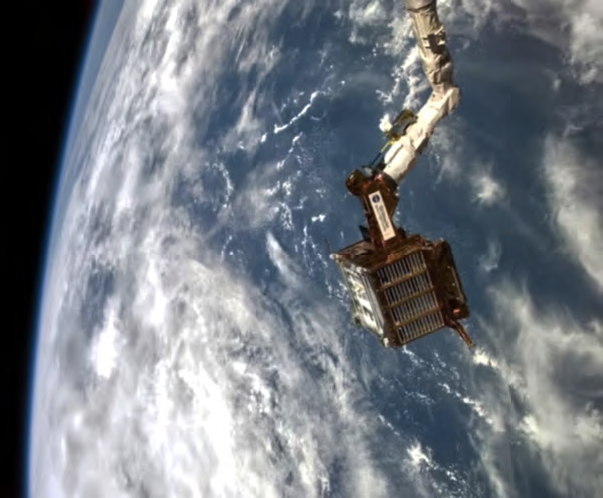 In addition to hosting Industry Days and Reverse Industry Days with commercial space industry professionals, COMSO has held several forums with venture capital and investment communities...
In addition to hosting Industry Days and Reverse Industry Days with commercial space industry professionals, COMSO has held several forums with venture capital and investment communities...
“having very frank conversations with the investment community and telling them this is what we need,” Kniseley said. “Explaining, here are the mission areas that we care about, so they are informed and understand ‘Ok, this is where the government wants to go.’ That enables them to start looking for companies to do some early investment and it’s up to us (industry) to show how they can scale that for production.” COMSO also launched its Commercial Space Marketplace for Innovation and Collaboration (COSMIC) in 2023. A collaboration between SSC and Virginia Tech Applied Research Corporation (VT-ARC), the Chantilly, Virgina, center is designed to facilitate SSC collaboration with the commercial industry, drive synergies with government agency partners, and deliver capabilities to the warfighter with greater speed and cost efficiency.
“Our adversaries aren’t going to stop challenging our Nation for space dominance,” Kniseley said. “If we want to stay ahead of the threat, it’s going to take everyone – Space Force, other government partners, commercial space industry partners – working together to improve the resiliency of our space architecture, deliver new and more lethal capabilities to our warfighters, and innovate at the speed of the fight.”
www.ssc.spaceforce.mil

